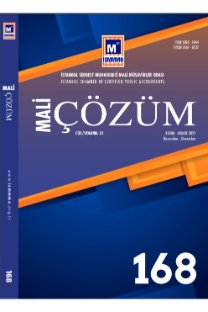NORMATİF MUHASEBE TEORİLERİ KAPSAMINDA ÖLÇÜM
Finansal tabloların amacı; borç verenlere ve kredi veren diğer taraflara raporlayan işletmeye kaynak sağlama kararlarını verirken faydalı olacak finansal bilgiyi sağlamaktır. Bu amaca ulaşılması için varlıkların uygun bir ölçü kullanılarak değerlenmesi gerekir. Normatif muhasebe teorileri, faydalı ve güvenilir bilginin finansal tablolarda raporlanabilmesi için çeşitli varlık değerleme yaklaşımları önermektedir. Bu çalışmada söz konusu yaklaşımlar ele alınmıştır.
MEASUREMENT UNDER NORMATIVE ACCOUNTING THEORIES
The objective of financial statements is to provide information about the financial position, financial performance, and cash flows of an entity that is useful to a wide range of users in making economic decisions. To achieve this objective, assets must be valued by using the proper measurement basis. Normative accounting propose various various asset valuation approaches in order to report useful and reliable information in financial statements.
___
- Abdel-Khalik (2011). "Fair Value Accounting and Stewardship", Accoun- ting Perspectives, 9; 4 (2011): 253-269.
- Barth, Mary E. (2014). "Measurement in Financial Reporting: The Need for Concepts", Accounting Horizons, 28; 2 (2014): 331-352.
- Botasan, Christine A. ve Huffman, Adrienna A. (2015). "Decision-Useful Asset Measurement from a
- Business Valuation Perspective", Accounting Horizons, 29; 4 (2015): 757-776.
- Brousseaua, Carl; Gendronb, Michel, Be'langerb, Phillippe ve Couplan- dc, Jonathan (2014). "Does fair value accounting contribute to market price volatility? An experimental approach", Accounting and Finance, 54 (2014): 1033-1061.
- Chambers, R.J. (1955) 'Blueprint for a theory of accounting', Accounting Research (January), 17-55.
- Chambers, R.J. (1966) Accounting, Evaluation and Economic Behavi- or, Englewood Cliffs, NJ: Prentice-Hall.
- Chambers, R.J. (1995) 'An introduction to price variation and inflation accounting research', in: Jones, S., Romana, C. & Ratnatunga, J. (eds.) Ac- counting Theory: A Contemporary Review, Sydney:
- Edwards, E. (1975) 'The state of current value accounting', Accounting Review, 50 (2), 235 - 245.
- Edwards, E.O. & Bell, P.W. (1961) The Theory and Measurement of Business Accounting for Changing Prices and Asset Values Income, Ber- keley, CA: University of California Press.
- Ellul, Andrew; Jotikasthira, Chotibhak, Lundblad, Christian T. ve Wang, Yihui. (2014). "Mark-to-market accounting and systemic risk: evidence from the insurance industry", Economic Policy, April (2014) : 279-341.
- Kaya, Can Tansel (2013). "Fair Value versus Historical Cost: Which is actually more "Fair"?", Muhasebe ve Finansman Dergisi, (Ekim 2013) : 127-137.
- Laux, C. & Leuz, C. (2009) 'The crisis of fairvalue accounting: Making sense of the recent debate', Accounting, Organizations and Society, 34 (6- 7): 826-34.
- Linsmeier, Thomas J. (2013). "A Standard setter's framework for selecting between fair value and historical cost measurement attributes: a basis for dis- cussion of ''Does fair value accounting for nonfinancial assets pass the market test?'', Rev Account Stud, 18 (2013): 776-782.
- Smith, Sheldon R. ve Smith, Kevin R. (2014). "The journey from historical cost accounting to fair value accounting: the cace of acquisition costs", Jour- nal of Business and Accounting, 7; 1 (2014): 3-10.
- Whittington, Geoffrey. (2015). "Measurement in Financial Reporting: Half a Century of Research and Practice", ABACUS, 51; 4 (2015): 549-571
- ISSN: 1303-5444
- Yayın Aralığı: Yılda 6 Sayı
- Başlangıç: 1991
- Yayıncı: İstanbul Serbest Muhasebeci Mali Müşavirler Odası
Sayıdaki Diğer Makaleler
TRANSFER FİYATLANDIRMADA OECD YAKLAŞIMI AÇISINDAN GELENEKSEL İŞLEM YÖNTEMİ VE UYGULAMA ÖRNEKLERİ
NORMATİF MUHASEBE TEORİLERİ KAPSAMINDA ÖLÇÜM
DEĞER İLİŞKİSİ ÜZERİNE ULUSLARARASI YAYINLAR
VOLKAN DEMİR, MELİK ERTUĞRUL, Ece GÜR
ULUSAL VE ULUSLARARASI BOYUTUYLA ELEKTRONİK TİCARETİN VERGİLENDİRİLMESİNDE TİCARİ KAZANCIN TESPİTİ
Metin YILMAZ, Halil Baba TAKKABULAN
GÜMRÜK UZLAŞMA MÜESSESESİ UYGULAMASINDA YASALLIK SORUNU
